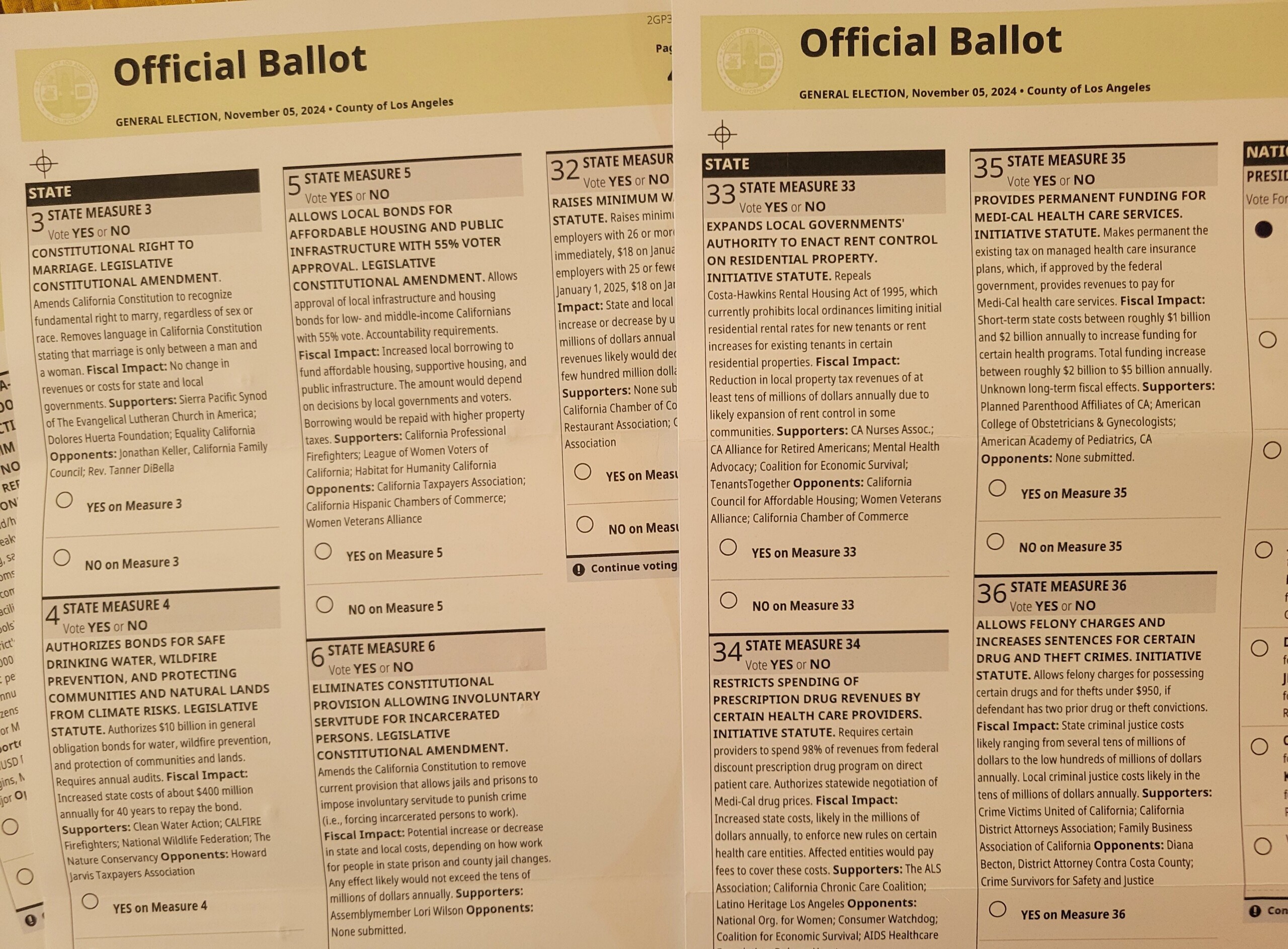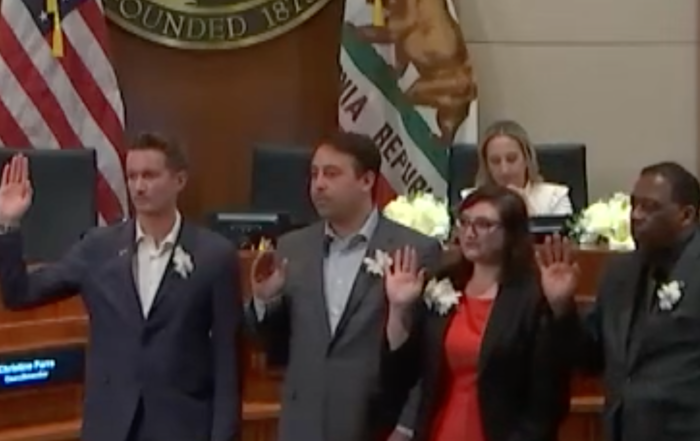Every two years, Californians must sift through the pros and cons of several statewide ballot initiatives and 2024’s crowded presidential election ballot is no exception. Here are our recommendations for voters on Propositions 32, 33, 34, 35, and 36:
Proposition 32 – the $18 Minimum Wage Initiative – YES
It’s important to remember that eight years ago, a bill was passed to gradually raise the state’s minimum wage to $15/hour by January 1, 2022, for businesses with 26 or more employees, and January 1, 2023, for smaller employers. The minimum wage would then be adjusted every year based on the increase in the Consumer Price Index (CPI). So this isn’t a massive jump from the Federal minimum wage of $7.25. And employers adjusted.
But prices have risen and monthly rent for most apartment dwellers has soared to unsustainable levels. This measure would increase the state minimum wage to $18/hour for organizations with 26 employees or more on January 1, 2025, and January 1, 2026, for smaller employers. The measure’s sponsor, investor Joe Sanberg, said “The time is now because the pandemic has heightened the people’s understanding of the realities so many Californians face. Cost of living is rising faster and faster… but wages haven’t increased commensurately.”
We agree. California is an expensive place to live, and employers should already know we are not a cheap labor state.
Proposition 33 – the Prohibit State Limitations on Local Rent Control Initiative – YES
Prop 33 is probably the most controversial among 2024’s state measures. Sponsored by the AIDS Healthcare Foundation, which has attempted two other ballot initiatives supporting rent control, this measure is different in that it would repeal the Costa-Hawkins Rental Housing Act of 1995. What’s Costa-Hawkins? It was the bill that allowed for “vacancy decontrol,” or for a housing unit’s rent to jump to the market rate for the new tenant when vacated by the outgoing tenant, and then be re-controlled at that rate.
Costa-Hawkins, implemented for most housing units on January 1, 1999, has been a boon for landlords for the last 25 years. They’ve seen huge profits as renters have moved around and vacated tens of thousands of apartments. But it is clear to any objective observer that rents have become unaffordable. Putting control of rent increases back in the hands of cities that have some form of rent control or rent stabilization is therefore the right thing to do.
Critics argue that returning control of rent increases for vacancies will stifle developers from building more much-needed multi-family apartment buildings. This is where the initiative should also have spoken to “rolling rent-control,” a process that would say to housing developers – build new housing and we will let you recoup the costs of building plus some profit for the first 10-15 years before making a building’s units all subject to rent control. It unfortunately does not.
But to suggest the initiative “makes the housing crisis worse,” as the landlord lobby’s ads have beaten into the public, raises a question – for whom? It sure wouldn’t make it worse for the increasing number of rent-burdened households who are barely staving off homelessness and can’t live where they work. People need to remember affordability is also a big part of the housing crisis, and a good number of the homeless you’re seeing on the street have jobs. Vote yes.
Proposition 34 – the Require Certain Participants in Medi-Cal Rx Program to Spend 98 percent of Revenues on Patient Care Initiative – NO
Prop 34 is an absolute scam. While it sounds good to require pharma to spend almost the entirety of its revenue on patient care, it is disingenuous at its core.
According to Ballotpedia.org, a balanced source of unbiased election information, it requires “health care providers that spent over $100 million in any 10-year period on anything other than direct patient care and operated multifamily housing with over 500 high-severity health and safety violations to spend 98 percent of revenues from the federal discount prescription drug program on direct patient care,” and it penalizes “violators of the initiative with loss of tax-exempt status and licenses to operate health insurance plans, pharmacies, and clinics.”
The real objective of the initiative is to prevent the AIDS Healthcare Foundation (AHF) – sponsors of Prop 33 – from pursuing housing advocacy ever again. AHF makes a lot of its money through its pharmacies, and now for three election cycles in a row has spent millions sponsoring ballot initiatives to empower rent control. The landlord lobby doesn’t like that, so they’ve written the initiative to describe specifically one organization – AHF.
Think about it – its main sponsor is the California Apartment Association. Why would they give a damn about state prescription coverage? They don’t. They just want to nail AHF, which is why that organization has dubbed Prop 34 “the revenge initiative.”
Proposition 35 – the Creation of New Healthcare Fund Initiative – NO
Healthcare reimbursements for Medi-Cal patients are too low, and that makes doctors and hospitals less enthused about treating our lowest-income Californians who rely on Medi-Cal. A current tax on Managed Care Organizations (MCOs = insurers) helps fund Medi-Cal and other health programs but is due to expire in 2026. Prop 35 would make the tax permanent and dedicate a larger portion of it exclusively to shore up Medi-Cal. It all sounds good.
But Prop 35 is a classic case of “ballot box budgeting,” and we believe it’s the job of the state legislature and governor to iron out a fix to Medi-Cal reimbursement. Prop 35 is written by “Big Health Care” to largely insure larger returns. We’re not against them receiving more money for providing good service, we are just not enthused by them asking Californians to give them a permanent tax that may take away from other health programs.
There are also arguments that the measures constricting language may also make California health care less manageable if Federal Medicaid requirements change.
We’re not losing too much sleep if this one passes, but we think issues like this one are the job of the elected legislature and governor.
Proposition 36 – the Drug and Theft Crime Penalties and Treatment-Mandated Felonies Initiative – NO
Prop 36 is both unnecessary and damaging. Sadly, many Democrats will get sucked into this “tough on crime” measure, which makes several changes to Proposition 47, passed in 2014 to address prison overcrowding through alternative sentencing methods and reduce imprisonment for some nonviolent crimes. Tough-on-crime types say it has allowed for the proliferation in property crime and small thefts that we saw escalate during the COVID pandemic.
But by most measures, Prop 47 has succeeded. According to the Vera Institute for Justice, which opposes the measure, “Prop 36 would reverse the state’s gains in reducing the dangerous, racially unequal, and unconstitutionally crowded prison population (since 2014, California’s prison population has dropped 28 percent with reduced racial disparities).”
What’s more, Prop 47 mandated that savings recouped from less crowded prisons and reduced punishments be pooled to benefit anti-recidivism programs including mental health and drug and alcohol treatment programs. According to the LAO, this was $95 million in 2023 alone. Prop 36 would dramatically slash that money in favor of old-fashioned mass incarceration (of Black and Brown men) that began in California under Governor George Deukmejian in the 1980s.
This year, the legislature and governor already passed measures that address several concerns laid out in the measure, without the hits to anti-recidivism funding. So why put those programs at risk?
People say they are for criminal justice reform and restorative justice. Now they must prove it by voting no on 36.
Photo by the author.
Stay informed. Sign up for The Westside Voice Newsletter
By clicking submit, you agree to share your email address with Westside Voice. We do not sell or share your information with anyone.








